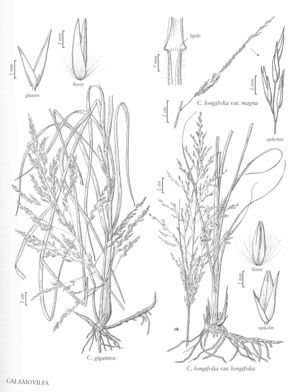Difference between revisions of "Calamovilfa longifolia var. longifolia"
Treatment appears in FNA Volume 25. Treatment on page 142.
FNA>Volume Importer |
FNA>Volume Importer |
||
| Line 37: | Line 37: | ||
|publication year= | |publication year= | ||
|special status= | |special status= | ||
| − | |source xml=https://jpend@bitbucket.org/aafc-mbb/fna-data-curation.git/src/ | + | |source xml=https://jpend@bitbucket.org/aafc-mbb/fna-data-curation.git/src/f6b125a955440c0872999024f038d74684f65921/coarse_grained_fna_xml/V25/V25_703.xml |
|subfamily=Poaceae subfam. Chloridoideae | |subfamily=Poaceae subfam. Chloridoideae | ||
|tribe=Poaceae tribe Cynodonteae | |tribe=Poaceae tribe Cynodonteae | ||
Revision as of 19:24, 24 September 2019
Sheaths usually glabrous, sometimes sparsely pubescent, rarely densely pubescent. Panicles to 55.5 cm long, usually 6.7-13.9 times as long as wide; branches to 23 cm long, erect or ascending, at least in the upper 1/3 of the panicle. Spikelets usually without a brownish cast, relatively closely imbricate.
Distribution
Colo., Iowa, Idaho, Kans., Mich., Minn., Mo., Mont., N.Dak., Nebr., N.Mex., S.Dak., Wyo., Wash., Alta., B.C., Man., Ont., Sask., Wis., Ill., Ind.
Discussion
Calamovilfa longifolia var. longifolia is a characteristic grass on the drier prairies of the interior plains, from southern Canada to northern New Mexico, with reports from southern Arizona. It also grows, as an adventive, in Washington, Wisconsin, Michigan, and Missouri.
Selected References
None.
Lower Taxa
None.
